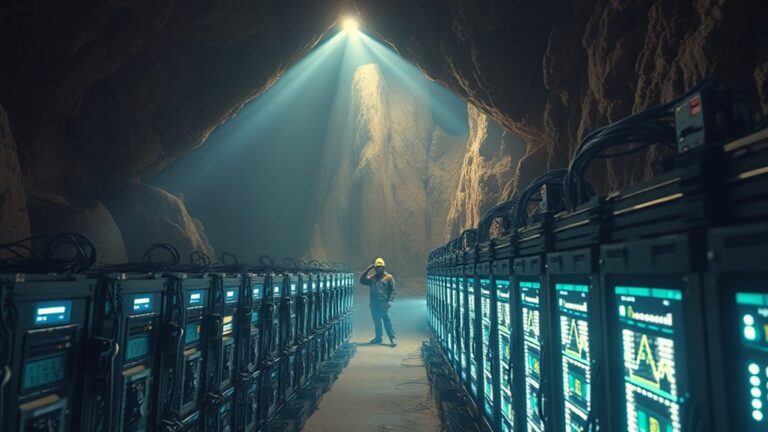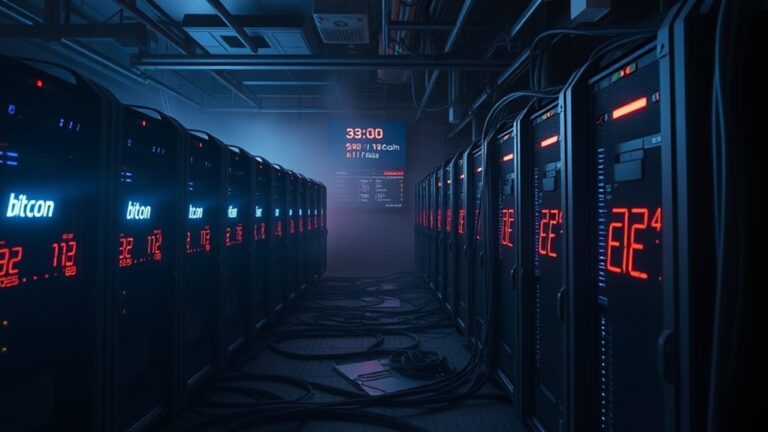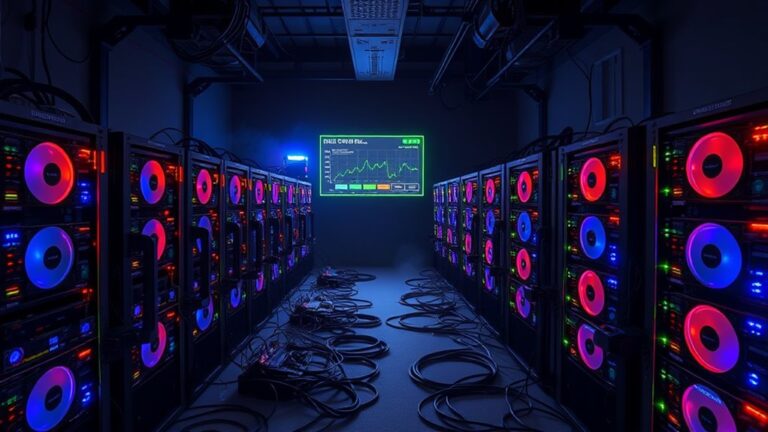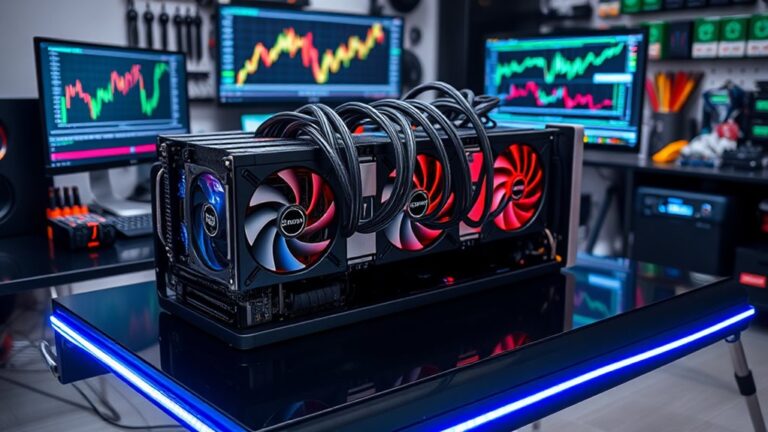
Types of Crypto Mining: How to Choose the Best Method for You
Crypto mining has several methods, including CPU, GPU, ASIC, and FPGA mining. Each method varies in cost, efficiency, and hardware requirements. Solo mining offers full rewards but is riskier, while pool mining increases chances of steady payouts. Energy consumption plays an essential role in profitability, as electricity costs greatly impact income. Choosing the best method depends on individual resources, location, and goals. Exploring further provides insights into profitability and future trends in crypto mining.
Key Takeaways
- Assess your budget and initial investment capacity, as different mining methods require varying levels of financial commitment for hardware and setup costs.
- Consider your electricity costs and availability, as mining efficiency is heavily influenced by energy expenses and location-specific rates.
- Choose between solo, pool, or cloud mining based on your risk tolerance and desired consistency in earnings; each method offers unique benefits and drawbacks.
- Evaluate the cryptocurrencies you want to mine, as specific hardware performs better with certain algorithms, impacting your choice of mining method.
- Stay informed about mining difficulty trends and renewable energy options to ensure long-term profitability and sustainability in your mining operations.
Understanding Different Crypto Mining Methods

Understanding different crypto mining methods is essential for anyone interested in the world of cryptocurrency.
There are various types of mining hardware used, including CPUs, GPUs, ASICs, and FPGAs. CPUs are generally slow and inefficient, while GPUs offer better efficiency and are widely used for specific cryptocurrencies. ASICs provide high performance but can raise fairness concerns.
Mining techniques also vary, with solo mining allowing individuals to mine independently, pool mining enabling collaboration among miners, and cloud mining allowing users to rent mining capacity.
Mining techniques differ significantly, with options for solo, pool, and cloud mining to suit various preferences and needs.
Additionally, consensus mechanisms like Proof of Work and Proof of Stake shape how transactions are validated. Each method has its advantages and challenges, influencing the decision-making of those entering the crypto mining landscape. Understanding the importance of transaction validation is crucial for selecting the right mining approach.
Cost Analysis of Mining Options

When evaluating the cost analysis of mining options, it is essential to take into account various factors that influence profitability and efficiency.
The cost to mine Bitcoin varies considerably based on location, with electricity being a primary expense. For instance, miners in Iran may spend around $1,324, while those in Ireland might face costs exceeding $321,112.
Equipment costs also play an important role, as specialized mining machines require substantial investments. Additionally, operational strategies, such as joining mining pools or utilizing energy-efficient hardware, can help manage expenses.
Industry averages suggest that production costs hover around $49,500 per Bitcoin, but these figures can increase when considering depreciation and inefficiencies. Understanding the impact of Bitcoin’s price volatility is essential for potential miners evaluating their options.
Efficiency and Energy Consumption
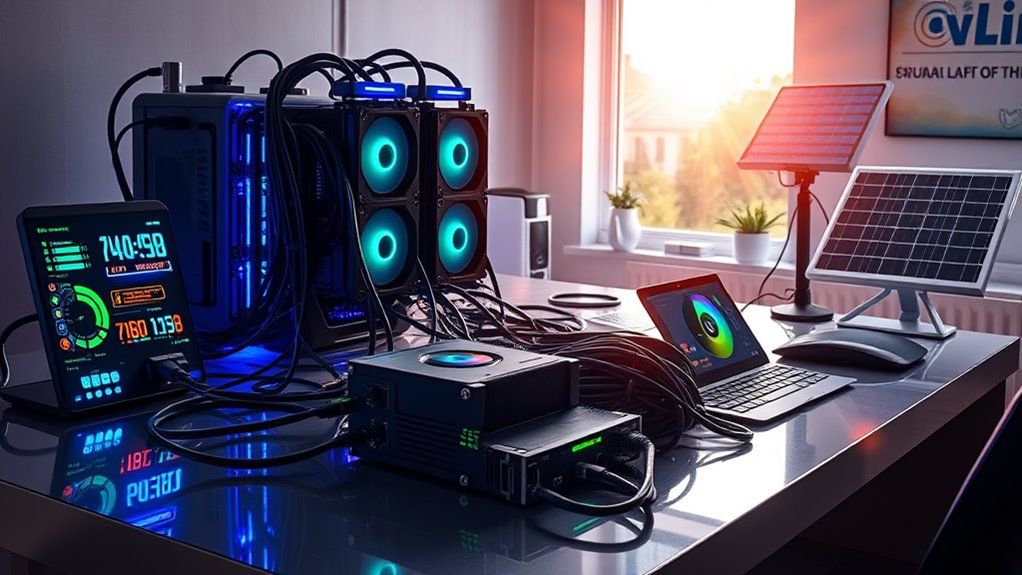
In the domain of cryptocurrency mining, understanding efficiency and energy consumption is vital for both profitability and environmental impact.
An energy cost analysis can highlight the financial implications of various mining methods, while an efficiency comparison chart can provide insights into the performance of different hardware options.
Additionally, sustainable mining practices are becoming increasingly important as miners seek to reduce their carbon footprint and comply with evolving regulations. Incorporating renewable energy sources can significantly enhance profitability while promoting eco-friendly mining operations.
Energy Cost Analysis
Energy cost analysis is a critical aspect of cryptocurrency mining, as it deeply influences both the profitability of mining operations and their environmental impact.
The global cryptocurrency market consumes over 68 TWh of energy annually, equivalent to the output of 19 coal-fired power plants. Despite efforts to utilize renewable energy, many Bitcoin mining operations rely on fossil fuels due to continuous energy demands.
The choice of mining hardware greatly affects energy efficiency, with ASIC miners offering superior performance compared to GPUs. Additionally, energy costs vary by location, impacting overall profitability.
Regulatory influences also shape mining practices, as regulations may promote energy efficiency or impose restrictions, further complicating the energy cost landscape for miners. Moreover, understanding how halvings impact blockchain profitability is essential for miners to adjust their strategies effectively in response to changing market conditions.
Efficiency Comparison Chart
Understanding mining efficiency is essential for evaluating the performance and cost-effectiveness of various cryptocurrency mining operations. Key metrics include hashrate efficiency, which measures how many hashes a device can produce per watt, and power consumption, which directly affects energy costs.
Different hardware types, such as ASICs, GPUs, and CPUs, exhibit varying efficiency profiles. For instance, the Bitmain Antminer S21 XP+ Hyd provides 500 TH/s at 5500 W, showcasing high efficiency for SHA-256 mining. In contrast, the Canaan Avalon Mini 3 offers 37.5 TH/s at 800 W, representing a more energy-efficient option.
Understanding these metrics, including Joules per Terahash (J/TH), allows miners to make informed decisions that optimize performance and reduce environmental impact. Additionally, miners must consider how mining difficulty fluctuates with changes in the network’s hash rate, as this directly affects their operational strategy and profitability.
Sustainable Mining Practices
Sustainable mining practices are becoming increasingly important as the cryptocurrency industry grapples with its energy consumption and environmental impact. Many mining operations are now shifting to renewable energy sources, such as solar, wind, and hydroelectric power, which greatly lowers their carbon footprint.
This change not only aligns with global climate goals but also enhances cost efficiency due to advancements in technology. Additionally, energy-efficient technologies, like innovative cooling systems and advanced mining hardware, further reduce energy consumption.
Mining operations can also support grid stability by adjusting their energy use based on demand. Furthermore, the adoption of sustainable mining techniques represents a vital step toward more sustainable and responsible cryptocurrency mining, contributing positively to the broader energy sustainability movement.
Hardware Requirements for Each Method
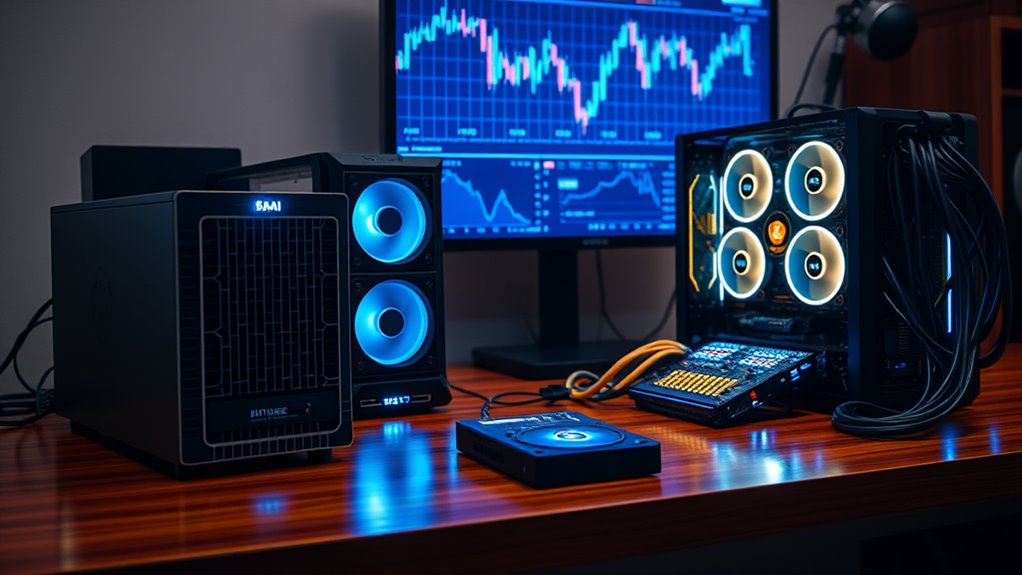
The hardware requirements for various crypto mining methods vary greatly, impacting both costs and efficiency. Each method has specific needs that influence the decision-making process for miners.
| Mining Method | Hardware Requirements |
|---|---|
| CPU Mining | Low-cost, but limited power and low hash rate. |
| GPU Mining | Moderate cost, medium power, and upgradable. |
| ASIC Mining | High cost, high efficiency, and specific to algorithms. |
| FPGA Mining | Moderate cost, programmable, but complex setup. |
CPU mining is largely obsolete due to inefficiency. GPUs offer flexibility for various cryptocurrencies. ASIC miners excel in efficiency but at a higher price. FPGAs provide customization but require technical skills, making each method unique in its hardware demands. Understanding the components necessary for building a mining rig is crucial for selecting the best mining method for your needs.
Mining Pools vs. Solo Mining

When miners consider their options for participating in cryptocurrency mining, they often weigh the benefits and drawbacks of solo mining against those of mining pools.
Solo mining allows individuals to maintain full control and retain 100% of the block rewards, but it comes with high risks, including long periods without rewards and significant resource demands.
Conversely, mining pools combine resources from multiple miners, leading to more consistent payouts and reduced operational costs.
However, pool members share the rewards and incur fees, which can diminish individual earnings. Additionally, miners in pools have limited autonomy, relying on the pool’s infrastructure.
Both methods contribute to network security and decentralization, making the choice dependent on individual preferences and risk tolerance. Ultimately, the decision hinges on whether miners prefer the consistent rewards offered by pools or the potential for larger payouts associated with solo mining.
Evaluating Profitability Factors

Evaluating profitability factors in crypto mining involves analyzing energy costs, mining difficulty trends, and hardware investment returns.
Energy expenses can greatly impact overall profits, especially as miners seek low-cost electricity sources.
Additionally, fluctuations in mining difficulty and the return on investment from hardware upgrades play essential roles in determining the long-term viability of mining operations. Moreover, the growing trend towards renewable energy sources is becoming crucial for miners looking to enhance sustainability and reduce costs.
Energy Cost Analysis
Understanding energy costs is essential for evaluating the profitability of crypto mining operations. The annual electricity consumption of the cryptocurrency market exceeds 68 TWh, resembling the output of over 19 coal-fired power plants.
Importantly, electricity expenses constitute approximately 62.12% of miners’ total income, making energy a significant factor in profitability. While miners often depend on fossil fuels, the integration of renewable energy sources can reduce costs and environmental impact. Moreover, the legal complexities surrounding mining operations can also influence energy sourcing decisions, as regulations may promote sustainable practices.
Efficient mining hardware plays a critical role as well, enhancing performance while lowering energy consumption. Ultimately, analyzing energy costs allows miners to make informed decisions regarding their operations, optimizing for both profitability and sustainability in a rapidly evolving industry.
Mining Difficulty Trends
Mining difficulty serves as an essential element in evaluating the profitability of cryptocurrency mining, as it directly influences the operational landscape for miners. This measure indicates how challenging it is to solve cryptographic puzzles required for validating transactions.
As mining difficulty fluctuates, several factors come into play:
- Increased network participation raises competition and difficulty.
- Difficulty adjustments occur every 2016 blocks, maintaining stable block times.
- Higher difficulty can diminish profitability unless miners invest in more powerful hardware.
- Historical trends show significant drops in difficulty during events like the mining ban in China.
Understanding these trends is vital for miners to assess their potential earnings and adapt their strategies accordingly in the ever-evolving crypto landscape.
Hardware Investment Returns
Profitability in cryptocurrency mining largely hinges on the returns from hardware investments, which encompass several critical factors. Central to this is the hash rate, where higher rates enhance the chances of earning rewards.
Additionally, lower power consumption is crucial, as it reduces operational costs. The choice between ASICs and GPUs also plays a significant role; while ASICs have higher upfront costs, they offer greater efficiency and returns in Bitcoin mining.
Moreover, efficient cooling systems can prolong hardware lifespan and mitigate costs. Market price fluctuations of Bitcoin influence overall profitability, making it essential for miners to monitor trends.
Trends and Future of Crypto Mining

As the cryptocurrency landscape evolves, several key trends are shaping the future of crypto mining.
These trends indicate a move towards more efficient, sustainable, and diversified mining practices.
The cryptocurrency mining industry is shifting towards greater efficiency, sustainability, and diversification in its practices.
- Hashrate derivatives help miners hedge against volatility.
- AI and HPC integration is creating new revenue opportunities.
- Renewable energy sources are being adopted to mitigate environmental impacts.
- Improved hardware offers better efficiency and accessibility.
These developments suggest that miners must adapt to changing market conditions, including increased regulatory oversight and competition.
The focus on sustainability and technological innovation will likely influence the profitability and viability of various mining methods in the coming years, steering the industry toward a more stable and responsible future.
Frequently Asked Questions
What Cryptocurrencies Can I Mine With Each Method?
Various cryptocurrencies can be mined using different methods. Cloud mining supports multiple coins, CPU mining suits lesser-known options like Monero, GPU mining benefits Ethereum Classic and Litecoin, while ASIC mining excels at Bitcoin and Litecoin.
How Do I Choose a Mining Pool?
Choosing a mining pool involves considering factors like pool size, reputation, and payout structure. Notably, larger pools can increase reward frequency but may diminish individual earnings, emphasizing the need for careful evaluation before selection.
Are There Risks With Cloud Mining Services?
Cloud mining services carry several risks, including unregulated platforms, hidden fees, operational instability, security vulnerabilities, and significant environmental impacts. Users must carefully evaluate these factors to make informed investment decisions in this volatile market.
Can I Switch Mining Methods Easily?
Switching mining methods resembles maneuvering through a labyrinth; each turn presents new challenges. While feasible, it requires careful evaluation of equipment, costs, and energy consumption, ensuring the new path aligns with one’s goals and market dynamics.
What Impact Does Mining Have on Device Lifespan?
Mining greatly impacts device lifespan, as continuous operation can lead to overheating and wear. Proper ventilation, maintenance, and temperature control are essential for extending the longevity of mining devices like GPUs and ASICs.
Conclusion
In conclusion, selecting the right crypto mining method requires careful consideration of various factors, including costs, efficiency, and hardware needs. Much like choosing a path in a labyrinth, miners must navigate through options such as solo mining and pools to find the most suitable route for their goals. As the crypto landscape continues to evolve, staying informed about trends and profitability will be essential for anyone venturing into this dynamic field.

